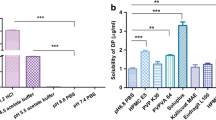Abstract
This article characterizes the stability of indinavir sulfate using different analytical techniques of quality control to evaluate important steps in the manufacturing process of indinavir, specifically involving storage and compression. Indinavir A, B, and C were obtained from different suppliers and submitted to DSC, Karl Fisher, NIR, XRPD analyses and dissolution assay. DSC curves of indinavir presented endothermic peaks of fusion at 149–150 °C for indinavir A and B (form I) and 139–143 °C for indinavir C (form II). When indinavir A and B were submitted to high Relative Humidity (RH) pseudo-polymorphic form II was formed. Indinavir C converted into an amorphous substance when submitted to compression. Near infrared and Karl Fisher assays detected high values of water for indinavir C in relation to indinavir A and B. X-ray powder diffraction of indinavir B and C showed displacement of 0.05–0.10 θ in the peaks and higher angle of diffraction in relation to indinavir A. Amorphous indinavir C demonstrated a higher intrinsic dissolution rate than indinavir A and B. Indinavir form I should be monitored during the pharmaceutical process to avoid its conversion to indinavir form II or an amorphous substance which can alter the dissolution rate.



Similar content being viewed by others
References
Brazilian Pharmacopeia. IV ed., supplement 1, p. 32. Brasil: DOU, seção 1, supplement nº209. Brasília: DF; 31 Oct 2005. p. 32.
Deeks SG, Smith M, Holodnly M, Kahn JO. HIV-1 protease inhibitors—a review for clinicians. J Am Med Assoc. 1997;277:145–53.
Da Silva RMF, De Morais FPM, Nascimento TG, Macêdo RO, Neto PJR. Thermal characterization of indinavir sulfate using TG, DSC and DSC photovisual. J Therm Anal Calorim. 2009;95:965–8.
Murakami FS, Lang KL, Mendes C, Cruz AP, Filho MASC, Silva MAS. Physico-chemical solid-state characterization of omeprazole sodium: thermal, spectroscopic and crystallinity studies. J Pharm Biomed Anal. 2009;49:72–80.
Gandhi R, Pillai O, Thilagavathi R, Gopalakrishnan B, Kaul CL, Panchagnula R. Characterization of azithromycin hydrates. Eur J Pharm Sci. 2002;16:175–84.
Bartolomei M, Rodomonte A, Antoniella E, Minelli G, Bertocchi P. Hydrate modifications of the non-steroidal anti-inflammatory drug diclofenac sodium: solid-state characterisation of a trihydrate form. J Pharm Biomed Anal. 2007;45:443–9.
Grant DJW. Theory and origin of polymorphism. In: Brittain HG, editor. Polymorphism in pharmaceutical solids. New York: Marcel Dekker; 1999. p. 1–33.
Macêdo RO, Medeiros AFD, Santos AFO, Souza FS, Júnior IDB, Procópio JVV, et al. Thermal studies of pre-formulates of metronidazole obtained by spray drying technique. J Therm Anal Calorim. 2007;89:775–81.
Santos AFO, Macedo RO, Junior IDB, Souza FS, Pinto AFD, Santana DP. Application of thermal analysis in study of binary mixtures with metformin. J Therm Anal Calorim. 2008;93:361–4.
Medeiros ACD, Macedo RO, Cervantes NAB, Gomes APB. Technological quality determination of pharmaceutical disintegrant by DSC cooling and DSC photovisual. J Therm Anal Calorim. 2007;88:311–5.
Giron D. Thermal analysis and calorimetric methods in the characterisation of polymorphs and solvates. Thermochim Acta. 1995;248:1–49.
Halebian J. Characterization of habits and crystalline modification of solids and their pharmaceutical applications. J Pharm Sci. 1975;64:1269–88.
Brittain HG. Methods for characterization of polymorphs and solvates. In: Brittain HG, editor. Polymorphism in pharmaceutical solids, vol. 95. New York: Marcel Dekker; 1999. p. 227–79.
Vrecer F, Vrbinc M, Meden A. Characterization of piroxicam crystal modifications. Int J Pharm. 2003;256:3–15.
Vogt FG, Brum J, Katrincic LM, Flach A, Socha JM, Goodman RM, et al. Physical, crystallographic, and spectroscopic characterization of a crystalline pharmaceutical hydrate: understanding the role of water. Cryst Growth Des. 2006;6:2333–54.
Chan HK, Grant DJ. Influence of compaction on disk intrinsic dissolution rates. Int J Pharm. 1989;57:117–24.
Jinno J, Crison JR, Amidon GL. Dissolution of ionizable water-insoluble drugs: the combined effect of pH and surfactant. J Pharm Sci. 2000;89:268–74.
Yu LX, Carlin AS, Amidon GL, Hussain AS. Feasibility studies of utilizing intrinsic dissolution rate to classify drugs. Int J Pharm. 2004;270:221–7.
The Merck Index. An encyclopedia of chemicals, drugs, and biologicals, 12th ed. Whitehouse Station, NJ: Merk & Co.; 1996.
Demir AS, Hamamci H, Doganel F, Ozgul E. Chemoenzymatic synthesis of (1S, 2R)-1-amino-2-indanol, a key intermediate of HIV protease inhibitor, indinavir. J Mol Catal B: Enzym. 2000;9:157–61.
Singh P, Premkumar L, Mehrotra R. Evaluation of thermal stability of indinavir sulphate using diffuse reflectance infrared spectroscopy. J Pharm Biomed Anal. 2008;47:248–54.
Kaul N, Agrawal H, Paradkar AR, Mahadik KR. The ICH guidance in practice: stress degradation studies on indinavir sulphate and development of a validated specific stability-indicating HPTLC assay method. IL FARMACO. 2004;59:729–38.
Czarnik-Matusewicz B, Pilorz S. Study of the temperature-dependent near-infrared spectra of water by two-dimensional correlation spectroscopy and principal components analysis. Vib Spectrosc. 2006;40:235–45.
Kaplan SA. Biopharmaceutical considerations in drug formation design and evaluation. Drug Metab Rev. 1972;1:15–34.
Kobayashi Y, Ito S, Itai S, Yanamoto K. Physicochemical properties and bioavailability of carbamazepine polymorphs and hydrate. Int J Pharm. 2000;193:137–46.
Di Martino P, Barthélémy C, Palmieri GF, Martelli S. Physical characterization of naproxen sodium hydrate and anhydrate forms. Eur J Pharm Sci. 2001;14:293–300.
Acknowledgements
The authors thanks to the CNPq for its financial support with grant number 402665/05-08 of the funding of research nº54/2005—Pharmaceutical Assistance/MS/CNPq. The authors also want to thank the Laboratório Industrial Farmacêutico do Estado de Alagoas (LIFAL) in the persons of Maria Rocha C. Acioli, manager of the department of quality assurance, Denise M. M. França and Solange S. Moura pharmacists and Maria Cícera C. Santos for the technical support in the selection of the raw materials, NIR and Karl Fisher analysis and Hallison M. Pires and Flaviano Gomes of for the intrinsic dissolution assay at the IDEF/UFPB. Also thanks are given to the Instituto de Macromoléculas Prof. Eloisa Mano at the Universidade Federal do Rio de Janeiro for its XRPD analysis.
Author information
Authors and Affiliations
Corresponding author
Rights and permissions
About this article
Cite this article
do Nascimento, T.G., Basílio Júnior, I.D., Macêdo, R.O. et al. Characterization of the indinavir raw materials stability in some pharmaceutical processes. J Therm Anal Calorim 102, 269–275 (2010). https://doi.org/10.1007/s10973-009-0446-0
Received:
Accepted:
Published:
Issue Date:
DOI: https://doi.org/10.1007/s10973-009-0446-0




